




Nestled amidst the towering peaks of the Himalayas, Bhutan is a hidden gem where ancient traditions thrive in harmony with nature. In this mystical Buddhist kingdom, time seems to slow, allowing you to immerse yourself in its serene beauty and deep-rooted culture.
With a private guide leading the way, journey through emerald valleys adorned with centuries-old fortresses and sacred shrines. Experience the heartbeat of Bhutan as you engage with monks, nuns, farmers, and artisans—each offering a glimpse into a way of life deeply intertwined with Mahayana Buddhism. Participate in timeless rituals, witness age-old customs, and observe the gentle evolution of this enchanting land, all while being fully present, undisturbed, and embraced by the magic of Bhutan.
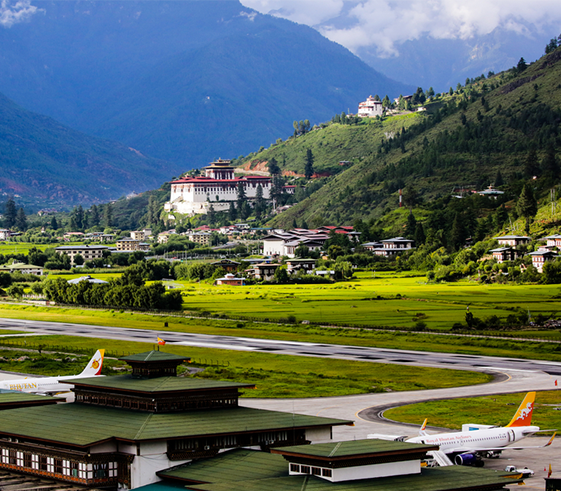
Arrival in Bhutan & Journey to Thimphu
On a clear morning flight from Bangkok to Paro, prepare for a breathtaking spectacle as the vast eastern Himalayas unfold beneath you. Glistening snow-capped peaks stretch into the horizon, including the majestic Kangchenjunga (8,586 meters / 28,169 feet), the world’s third-highest mountain, and Chomolhari (7,326 meters / 24,035 feet), Bhutan’s revered holy peak.
Upon landing in Paro (2,200 meters / 7,218 feet), you’ll clear immigration, collect your baggage, and pass through customs before stepping into the arrival hall. Here, you will be warmly welcomed by your Bhutanese guide and driver, who will accompany you throughout your journey, ensuring a seamless and enriching experience.
Leaving the airport, your adventure begins with a scenic drive to Thimphu (2,334 meters / 7,657 feet), Bhutan’s vibrant capital. Following the winding path of the Paro Chhu and Wang Chhu rivers, you’ll be immersed in the picturesque landscapes that define this enchanting kingdom. Thimphu is the heart of Bhutan’s governance, home to the royal family, government institutions, and international organizations. The city is also a hub for traditional craftsmanship, where artisans continue Bhutan’s legacy of weaving, metalwork, and papermaking.
Your exploration of Thimphu includes a visit to the National Textile Museum, where intricate handwoven fabrics and brocades showcase Bhutan’s rich textile heritage. If time permits, you may also visit the School of Zorig Chusum, where students master Bhutan’s thirteen traditional arts and crafts, from painting and woodcarving to embroidery and clay sculpting.
As evening falls, take a leisurely stroll through Thimphu’s charming streets, exploring local markets and the Crafts Bazaar, where you can find beautiful Bhutanese souvenirs, from prayer flags and silver jewelry to coral and turquoise beads. One of the city’s unique sights is its traffic policemen, who direct vehicles with graceful hand gestures—Thimphu remains one of the few capitals in the world without traffic lights.
For the next two nights, you’ll stay at Zhiwaling Ascent, a serene retreat nestled on the outskirts of Thimphu in Motithang. This contemporary Bhutanese-owned hotel offers panoramic views in a tranquil, park-like setting. Designed with sustainability in mind, its 20 spacious rooms are built to maximize natural light while offering breathtaking vistas of the surrounding mountains.
This evening, your guide will provide an orientation of your Bhutan journey, setting the stage for the incredible experiences ahead.
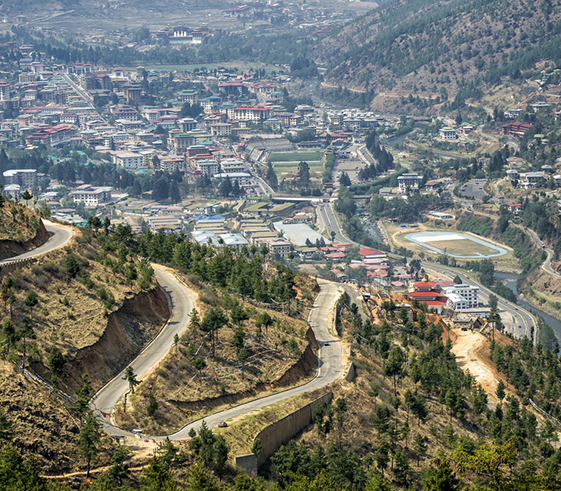
Morning Exploration: Buddha Dordenma & Cheri Monastery Hike
Begin your morning with a visit to the Buddha Dordenma, the world’s tallest seated Buddha statue, standing 51 meters (169 feet) high. This magnificent golden figure, built upon an ancient prophecy, faces east, radiating boundless love and compassion to all sentient beings. The enormous structure houses an expansive meditation hall at its base and two beautifully adorned chapels on the upper floors. Inside, you’ll be captivated by the intricate artwork, masterfully crafted by Bhutanese artisans. Beyond its spiritual significance, the site also offers panoramic views of the Thimphu valley below—a breathtaking start to your day.
Next, drive north of Thimphu for about 30 minutes to Dodena, where your hike to Cheri Monastery begins. Crossing a traditional cantilevered bridge over the Wangchu River, you’ll ascend gently through a lush temperate forest filled with oak, rhododendrons, and towering hardwood trees. Established in the early 1620s by Zhabdrung Rinpoche, the unifier of Bhutan, Cheri Monastery was Bhutan’s first monastic school and remains a sacred center for Buddhist studies. Here, monks dedicate themselves to philosophy, metaphysics, poetry, mathematics, and deep meditation. The peaceful surroundings and spiritual energy of this monastery make it an ideal place for quiet reflection.
After your hike, enjoy a delightful riverside picnic lunch along the banks of the Wangchu River before heading back to Thimphu.
On your return, stop by the Pangrizampa School of Astrology, where you can have a personal reading by an astrologer, offering insights into your past, present, and future based on Bhutanese astrological traditions.
This enriching day combines spiritual discovery, cultural exploration, and nature’s tranquility, offering a deeper connection to Bhutan’s sacred landscapes.
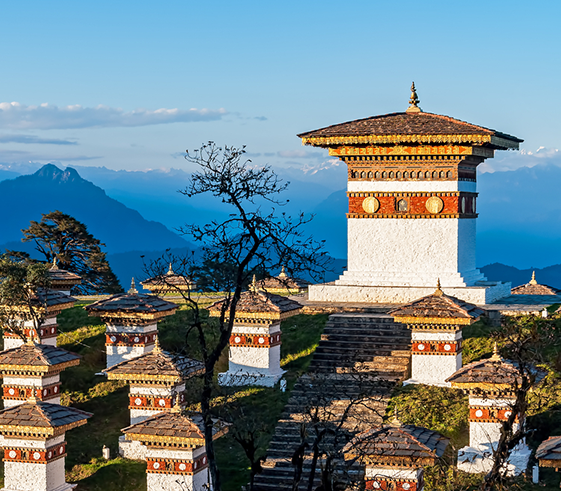
Journey to Punakha via Dochu La Pass & Cultural Encounters
After a leisurely breakfast, begin your day with a visit to the Green Weaving Center, where you’ll witness Bhutanese artisans skillfully weaving intricate textiles using natural dyes and sustainable materials. This visit offers a unique insight into Bhutan’s rich textile heritage and the traditional techniques passed down through generations.
From here, embark on a scenic drive toward Punakha, crossing the breathtaking Dochu La Pass (3,140m / 10,300ft). On a clear day, the pass offers 360-degree panoramic views of the snow-capped Himalayas, stretching over 200 miles, including Bhutan’s tallest peak, Gangkar Puensum (7,570m / 24,836ft)—the world’s highest unclimbed mountain. The pass is adorned with 108 chortens (stupas), creating a serene and picturesque setting for photography and short walks. From here, descend gradually into the warmer, subtropical valleys of Punakha, where the lush landscapes shift from alpine forests to terraced rice fields.
Upon reaching the charming village of Sopsokha, enjoy a gentle hike (2 km / 1.2 miles round trip) through scenic farmlands to Chimi Lhakhang, a revered fertility temple dedicated to Drukpa Kunley, affectionately known as the Divine Madman. This eccentric Buddhist saint, renowned for his unorthodox teachings, is one of Bhutan’s most beloved figures. Many couples seeking fertility blessings visit this temple, where around 25 young monks undergo monastic education. After exploring the temple, enjoy a traditional Bhutanese lunch at a local restaurant nearby.
Conclude your day with a visit to the Wolakha Nunnery, perched atop a hill overlooking the surrounding valleys. Home to a community of Buddhist nuns, the nunnery serves as both a monastic school and a meditation retreat. Apart from their spiritual practices, the nuns engage in appliqué and thangka painting, keeping Bhutanese artistic traditions alive. The main shrine is dedicated to Chenrezig (Avolokiteshvara), the Bodhisattva of Compassion, whose presence fills the space with an aura of serenity.
HOTEL : in Punakha – Your stay at this stunning retreat embraces the rustic charm of Punakha, blending seamlessly with the lush valley of rice paddies and traditional farmhouses. With sweeping panoramic views, the lodge offers a tranquil escape, perfectly complementing Punakha’s warm, inviting climate.
This day beautifully combines scenic landscapes, cultural immersion, and spiritual encounters, setting the tone for an unforgettable Bhutanese journey.
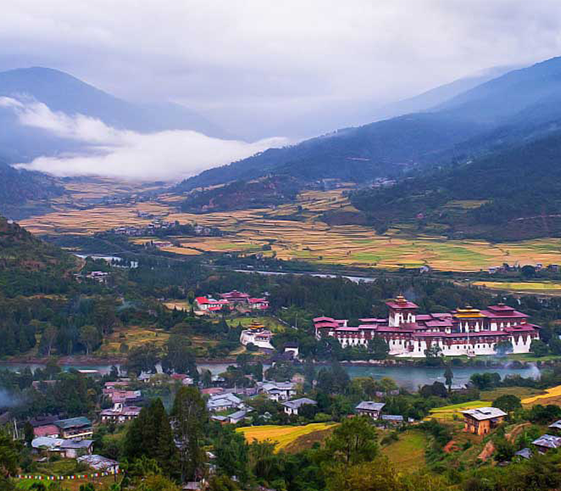
Begin your day with a scenic drive to Hebisa village, the starting point for your one-hour hike to the magnificent Khamsum Yulley Namgyal Chorten, an architectural gem perched atop a ridge overlooking the lush Punakha Valley. Commissioned by Her Majesty Ashi Tshering Yangdon Wangchuck, the mother of Bhutan’s King, this chorten was built as a spiritual offering for the peace and prosperity of Bhutan.
The multi-tiered structure is adorned with intricate Bhutanese artistry, each level showcasing meticulously crafted statues of protector deities. The true highlight of your visit is the rooftop terrace, offering breathtaking panoramic views of the valley’s terraced rice fields and the winding Mo Chhu River.
The gradual hiking trail meanders through picturesque farmlands, where you’ll pass vibrant rice paddies and chili plantations. During the wet season, you may see farmers plowing their fields using traditional oxen-drawn plows, a timeless agricultural practice passed down through generations. If the opportunity arises, you may even join the farmers, gaining firsthand insight into Bhutan’s rural way of life.
After descending from the chorten, return to Hebisa Bridge and continue to a riverside campsite along the Mo Chhu, where you will enjoy a peaceful picnic lunch, surrounded by the serene beauty of Punakha’s landscapes.
Once the ancient capital of Bhutan until the mid-1960s, Punakha remains one of the most significant and picturesque valleys in the kingdom. Blessed with a mild climate, its fertile lands yield rice, chilies, vegetables, and tropical fruits. Each winter, the Central Monastic Body, led by the Chief Abbot of Bhutan, relocates from Thimphu to Punakha for six months, taking advantage of the valley’s warmer weather.
After lunch, visit the majestic Punakha Dzong, an architectural masterpiece set at the confluence of the Pho Chhu ("Father River") and Mo Chhu ("Mother River"). Built in 1637 by Zhabdrung Ngawang Namgyal, the unifier of Bhutan, this dzong is considered one of the grandest and most sacred fortresses in the country, housing Bhutan’s most revered relics.
Bhutanese dzongs were designed to serve three main purposes:
✔ Fortresses – Acting as military strongholds during times of invasion.
✔ Administrative Centers – Serving as the regional headquarters for governance.
✔ Monastic Residences – Functioning as religious institutions for Buddhist studies.
As you wander through the grand courtyards, admire the intricately carved wooden balconies and sacred shrines. Photography is permitted in the courtyards, allowing you to capture the grandeur of this historic fortress, set against the stunning backdrop of Punakha’s breathtaking landscapes.
This immersive journey through Punakha offers the perfect blend of spiritual discovery, cultural heritage, and scenic beauty, leaving you with unforgettable memories of Bhutan’s timeless traditions and sacred landscapes.
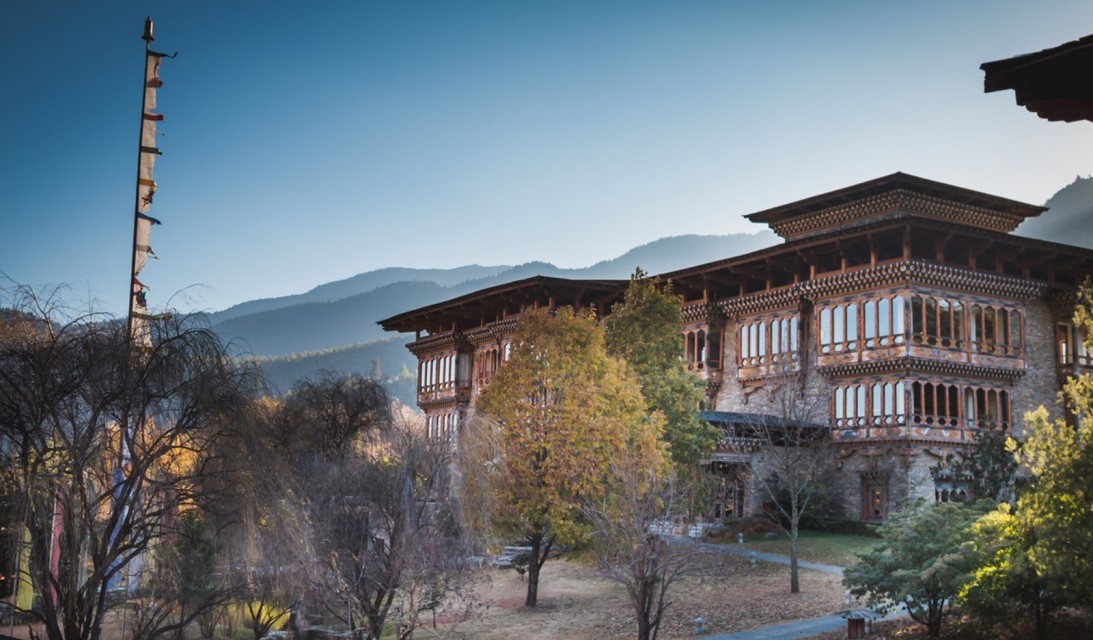
This morning, embark on a scenic drive back to Paro, once again crossing the breathtaking Dochu La Pass before descending into the picturesque Paro Valley. Following the course of the Pa Chhu (Paro River), you’ll arrive in Paro, often referred to as the “Rice Bowl of Bhutan”—renowned for its premium-quality rice, which is even exported to North America and Europe.
Nestled amidst towering Himalayan peaks, Paro is a charming historic town in western Bhutan, characterized by narrow streets, brightly painted wooden shops, and a rich cultural legacy. Once a vital hub for trade with Tibet, the valley continues to be a center of tradition, spirituality, and heritage.
Ascend a gentle hill to one of Paro’s most iconic structures—the Ta Dzong, a circular fortress that once safeguarded the valley from northern invasions. Today, it houses the National Museum of Bhutan, home to priceless relics, ancient artifacts, and exquisite Bhutanese treasures since 1968. The watchtower also offers breathtaking panoramic views of the valley below.
Descending from Ta Dzong, visit the magnificent Paro Rinpung Dzong, a fortress-monastery that played a crucial role in defending Bhutan from Tibetan invasions. Its imposing architecture even inspired the University of El Paso, Texas, USA, which maintains strong cultural ties with Bhutan, offering scholarships to Bhutanese students. The Hollywood film "Little Buddha" was filmed in the courtyards of this majestic stronghold, adding to its global significance.
As you explore the dzong, admire its intricate woodwork, grand courtyards, and sacred temples before taking a leisurely walk down to the traditional cantilevered bridge spanning the Paro River. Nearby, visit a Buddhist Art Gallery, where local master artisans can be seen meticulously working on thangka paintings and traditional Bhutanese art. If interested, you may observe their techniques or browse through the collection of artworks available for purchase.
Your stay in Paro will be at Zhiwa Ling Heritage, an award-winning boutique hotel set on 10 acres of pristine valley land, within close reach of Bhutan’s most revered temples and monasteries. Seamlessly blending traditional Bhutanese craftsmanship with modern comforts, the hotel features a 450-year-old temple, alongside contemporary touches such as Swedish under-floor heating. In 2015, Zhiwa Ling Heritage was honored with the National Geographic Unique Lodge of the World Award, recognizing it as one of the most sustainable and culturally immersive hotels in the world.
This enchanting day in Paro offers a harmonious blend of history, spirituality, and architectural splendor, setting the perfect stage for your continued journey through Bhutan.
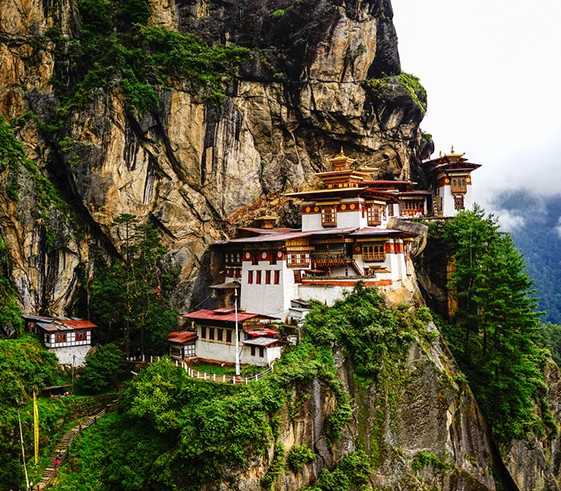
This morning, embark on an unforgettable journey to the Taktsang Monastery, famously known as Tiger’s Nest, an architectural marvel perched dramatically on a sheer granite cliff, 2,500 feet above the valley floor.
According to legend, in 747 CE, Guru Rinpoche (Padmasambhava), in his wrathful manifestation as Guru Dorji Drolo, flew to this sacred site on the back of a tigress to subdue malevolent spirits and bless the region with Buddhist teachings. Today, it stands as Bhutan’s most revered pilgrimage site and an enduring symbol of spiritual devotion and resilience.
Your adventure begins with a scenic drive to the trailhead, where, like countless pilgrims before you, you will embark on a challenging yet rewarding hike. The initial stretch is a steep ascent through fragrant pine forests, punctuated by fluttering prayer flags and chortens (stupas). After about an hour of uphill hiking, take a well-deserved break at a traditional teahouse, where you’ll be rewarded with stunning panoramic views of the monastery clinging to the cliffside.
For those seeking an even closer perspective, continue hiking for another hour to a small chorten directly opposite the monastery, offering a breathtaking vantage point. The final approach involves descending—and then ascending—750 stone steps, crossing a prayer-flag-laden gorge, and passing a hidden waterfall, before finally arriving at the awe-inspiring Tiger’s Nest Monastery. Take your time to explore the sacred halls, soak in the mystical ambiance, and appreciate the monastery’s profound spiritual significance.
In the evening, visit one of Bhutan’s oldest and holiest temples, Kyichu Lhakhang, dating back to the 7th century. Built by Tibetan King Songtsen Gampo as part of his divine mission to subdue a giant ogress hindering the spread of Buddhism, this revered temple is often called "The Wish-Fulfilling Temple."
Here, you may encounter elderly Bhutanese devotees circumambulating the temple, turning prayer wheels, and murmuring mantras—a heartwarming glimpse into Bhutan’s deeply rooted Buddhist traditions. Feel free to engage in conversation with them; they will be delighted to share blessings and stories with visitors.
Afterward, drive to Paro town for some last-minute shopping or a leisurely evening stroll through the charming streets. End your final night in Bhutan with a memorable farewell dinner, celebrating new friendships and unforgettable experiences.
Optional Experience:
After your hike, indulge in a traditional Bhutanese hot stone bath, a therapeutic soak that will soothe sore muscles and rejuvenate your spirit—the perfect way to conclude this extraordinary day.
This final day in Bhutan is a testament to adventure, spirituality, and cultural immersion, leaving you with memories that will last a lifetime.
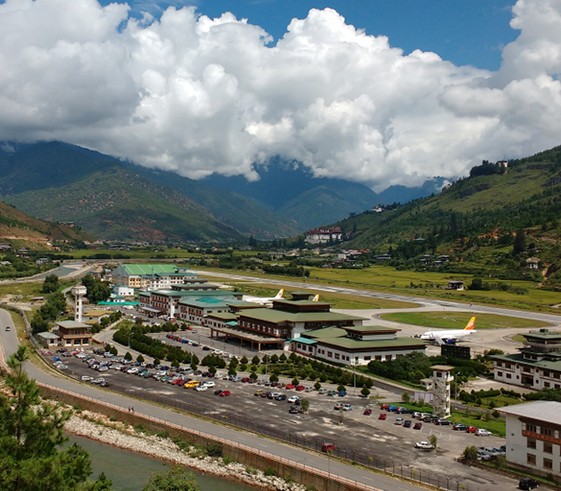
As your extraordinary journey through Bhutan comes to an end, your guide and driver will accompany you to the airport, ensuring a smooth departure and bidding you a heartfelt farewell.
Over the past days, you have explored Bhutan’s breathtaking landscapes, hiked to sacred monasteries, immersed yourself in the country’s rich cultural heritage, and connected with its warm and hospitable people. From the snow-capped peaks of the Himalayas to the serene valleys adorned with fluttering prayer flags, every moment has been a testament to the beauty, spirituality, and tranquility of this hidden Himalayan kingdom.
As you board your flight, take one last glimpse at the misty mountains and the verdant valleys below—a land where happiness is not just a pursuit but a way of life. Though you may be leaving Bhutan, its magic will remain in your heart forever.
We hope you carry with you not just memories but the essence of Bhutan’s peace, wisdom, and joy—a reminder that the simple moments in life, filled with gratitude and connection, are the most precious.
Until we meet again, we wish you safe travels, good fortune, and endless adventures ahead.
Tashi Delek & Bon Voyage!



